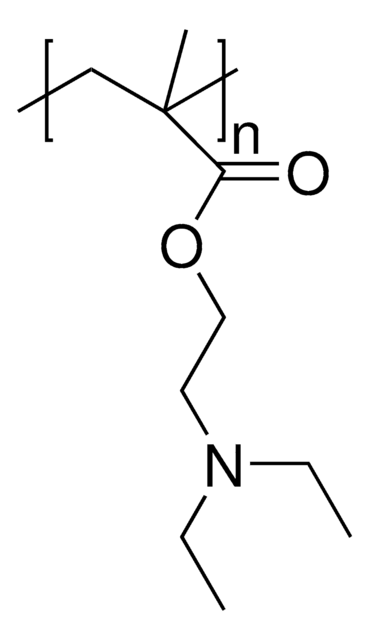推薦產品
形狀
powder or solid
分子量
average Mn 10,000 (by NMR)
average Mn 10,000
顏色
white to faint yellow
蛋白質二硫鍵異構酶
≤1.3 (by GPC)
儲存溫度
2-8°C
應用
Poly(2-(diisopropylamino)ethyl methacrylate) is a pH-responsvie polymer. pH-Responsive polymers are a group of stimuli-responsive polymers that can respond to solution pH by undergoing structural and property changes such as surface activity, chain conformation, solubility, and configuration. The term “pH-responsive polymers” is commonly used to describe polymers having ionisable acidic or basic residues whose ionization depends on solution pH. The physical properties of the polymer, such as its chain conformation, configuration, and solubility, can be tailored by manipulating the pH or ionic strength. These unique properties of pH responsive polymer systems consequently make them very useful in various applications such as drug delivery, gene delivery, sensors, surfaces, membranes, and chromatography.
pH-sensitive polymer systems combined with nanotechnology could be utilized as an alternative strategy to traditional targeting systems to overcome major problems in current chemotherapy represented by non-specific tissue distribution of the drugs, tumor heterogeneity, and multidrug resistance (MDR) against anticancer drugs.
pH-sensitive polymer systems combined with nanotechnology could be utilized as an alternative strategy to traditional targeting systems to overcome major problems in current chemotherapy represented by non-specific tissue distribution of the drugs, tumor heterogeneity, and multidrug resistance (MDR) against anticancer drugs.
儲存類別代碼
11 - Combustible Solids
水污染物質分類(WGK)
WGK 3
閃點(°F)
Not applicable
閃點(°C)
Not applicable
pH-Responsive polymers
Kocak G, et al.
Polym. Chem., 8, 144-176 (2017)
Jing Xie et al.
Macromolecular rapid communications, 38(23), 1499-1499 (2017-10-05)
Since diabetes mellitus has become one of the most serious threats to human health, researchers have been designing new drugs and developing new technologies to control the blood glucose level (BGL) while improving patient compliance. In addition to the traditional
Girish Kumar Tripathi et al.
Current drug delivery, 8(6), 667-677 (2012-02-09)
Helicobacter pylori reside in the gastric mucus layer and at the mucus-epithelial cell interface wherein access of antimicrobial drug to the infection site is restricted both from the stomach and from the gastric blood supply. The aim of the present
pH-sensitive polymers for drug delivery.
Huh K M, et al.
Macromolecular Research, 20(3), 224-233 (2012)
Hong-ming Ding et al.
Scientific reports, 3, 2804-2804 (2013-10-01)
The major challenge in cancer therapy is to efficiently translocate drug molecules into cancer tumors without doing any damage to healthy tissues. Since there exist pH gradients between tumor and normal tissues, pH-sensitive materials may have great potential to overcome
Active Filters
我們的科學家團隊在所有研究領域都有豐富的經驗,包括生命科學、材料科學、化學合成、色譜、分析等.
聯絡技術服務




![N-[(3-(二甲氨基)丙基]甲基丙烯酰胺 99%, contains MEHQ as inhibitor](/deepweb/assets/sigmaaldrich/product/structures/295/145/6b4aae15-7cb5-4b7b-9c06-8e6d24e50951/640/6b4aae15-7cb5-4b7b-9c06-8e6d24e50951.png)
![N,N,N-三甲基-2-[(2-甲基-1-氧-2-丙烯基)氧基]乙胺盐酸盐的均聚物](/deepweb/assets/sigmaaldrich/product/structures/163/044/f30ee849-f8fd-47ec-811f-f24cc48a80dd/640/f30ee849-f8fd-47ec-811f-f24cc48a80dd.png)


![[2-(甲基丙烯酰氧基)乙基] 三甲基氯化铵 溶液 75 wt. % in H2O](/deepweb/assets/sigmaaldrich/product/structures/316/612/66b0f4cf-d060-427d-b4f5-e8fab3e5cffe/640/66b0f4cf-d060-427d-b4f5-e8fab3e5cffe.png)